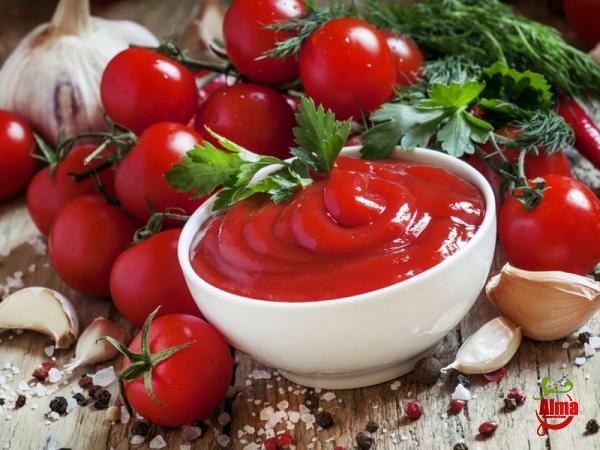An In-Depth Overview Introduction: Tomato paste is a versatile and widely used product derived from tomatoes that are processed and concentrated into a thick paste. With its rich flavor and vibrant red color, tomato paste is a staple ingredient in various cuisines around the world. This article aims to provide an in-depth overview of tomato paste, including its production process, nutritional profile, storage methods, culinary uses, and potential health benefits. 1. Production Process: Tomato paste is made by cooking ripe tomatoes, removing the skin and seeds, and reducing the remaining pulp to a concentrated form. The process typically involves several steps, including sorting and washing the tomatoes, blanching, peeling, and deseeding. The pulp is then cooked and reduced to a thick consistency before being packaged and sterilized for preservation. 2. Nutritional Profile: Tomato paste offers an array of essential nutrients. It is a rich source of vitamins A, C, and K, as well as antioxidants like lycopene, which gives tomatoes their red color. Lycopene has been associated with numerous health benefits, including reduced risk of certain cancers and cardiovascular diseases. Tomato paste also contains minerals such as potassium and fiber, contributing to a well-balanced diet. 3. Culinary Uses: Tomato paste is a versatile ingredient widely used in various cuisines across the globe. Its deep flavor and texture make it a perfect base for sauces, soups, stews, and gravies. It adds depth and richness to dishes with its concentrated tomato flavor. Additionally, tomato paste can be used as a pizza topping, a spread for sandwiches, or a flavor enhancer for marinades or dressings. 4. Health Benefits: Apart from its nutritional content, tomato paste offers a range of health benefits. The lycopene found in tomato paste is a powerful antioxidant that helps protect against oxidative stress and inflammation. Studies suggest that regular consumption of tomato and tomato-based products, including tomato paste, may help reduce the risk of certain types of cancer, including prostate, stomach, and colorectal cancer. The lycopene in tomato paste is also associated with improved heart health by reducing blood pressure and LDL cholesterol levels. 5. Storage Methods: Proper storage is crucial to maintain the quality and taste of tomato paste. Most commercially available tomato paste comes in aseptic packaging or metal cans, which can be stored at room temperature until opened. Once opened, it is advisable to transfer the remaining paste into an airtight container and store it in the refrigerator. Properly stored, tomato paste can remain fresh for several weeks or even months. Freezing is another option for long-term storage, but it may affect the texture and flavor of the paste.

tomato paste
 6. Varieties and Packaging: Tomato paste is available in various forms, including concentrated paste, double concentrate, triple concentrate, and strained tomatoes. Concentrated tomato paste typically has a thicker consistency and more intense flavor compared to strained tomatoes, which have a more liquid-like consistency. Tomato paste is commonly packaged in cans, tubes, or aseptic containers, allowing for easy storage and convenience. 7. Tomato Paste Substitutes: In situations where tomato paste is not readily available, several substitutes can be used to achieve a similar flavor and texture. These substitutes include tomato sauce, canned tomatoes cooked and reduced, sun-dried tomatoes blended into a paste, or even ketchup. However, it is important to note that these substitutes may alter the flavor profile of the dish to some extent. Conclusion: Tomato paste is a versatile and essential ingredient in countless recipes, providing a concentrated tomato flavor and adding depth to a variety of dishes. Its production process involves careful processing and concentration to preserve the nutrients and flavor of ripe tomatoes. With its nutritional benefits and vibrant taste, tomato paste is a valuable addition to any kitchen pantry, elevating the flavors of meals while contributing to a healthy diet.I. Market Overview: The tomato paste market has experienced steady growth over the years, driven by factors such as increasing consumer preference for convenience foods, rising demand for processed tomato products, and the expanding food industry. The market is highly competitive, with numerous key players vying for market share through product innovation, quality control, and marketing strategies. II. Key Market Players: Some of the major players in the tomato paste industry include ConAgra Brands Inc., The Kraft Heinz Company, Chalkis Health Industry SA, Barilla Holding S.p.A., Symrise AG, and Del Monte Foods Inc. These companies are investing in research and development to improve the taste and nutritional quality of their tomato paste products, as well as exploring alternative packaging solutions to meet changing consumer preferences.
6. Varieties and Packaging: Tomato paste is available in various forms, including concentrated paste, double concentrate, triple concentrate, and strained tomatoes. Concentrated tomato paste typically has a thicker consistency and more intense flavor compared to strained tomatoes, which have a more liquid-like consistency. Tomato paste is commonly packaged in cans, tubes, or aseptic containers, allowing for easy storage and convenience. 7. Tomato Paste Substitutes: In situations where tomato paste is not readily available, several substitutes can be used to achieve a similar flavor and texture. These substitutes include tomato sauce, canned tomatoes cooked and reduced, sun-dried tomatoes blended into a paste, or even ketchup. However, it is important to note that these substitutes may alter the flavor profile of the dish to some extent. Conclusion: Tomato paste is a versatile and essential ingredient in countless recipes, providing a concentrated tomato flavor and adding depth to a variety of dishes. Its production process involves careful processing and concentration to preserve the nutrients and flavor of ripe tomatoes. With its nutritional benefits and vibrant taste, tomato paste is a valuable addition to any kitchen pantry, elevating the flavors of meals while contributing to a healthy diet.I. Market Overview: The tomato paste market has experienced steady growth over the years, driven by factors such as increasing consumer preference for convenience foods, rising demand for processed tomato products, and the expanding food industry. The market is highly competitive, with numerous key players vying for market share through product innovation, quality control, and marketing strategies. II. Key Market Players: Some of the major players in the tomato paste industry include ConAgra Brands Inc., The Kraft Heinz Company, Chalkis Health Industry SA, Barilla Holding S.p.A., Symrise AG, and Del Monte Foods Inc. These companies are investing in research and development to improve the taste and nutritional quality of their tomato paste products, as well as exploring alternative packaging solutions to meet changing consumer preferences.
Specifications of tomato paste
 III. Market Segmentation: The tomato paste market can be segmented based on packaging type, distribution channel, and application. Packaging types include cans, tubes, and aseptic containers. Distribution channels include supermarkets/hypermarkets, convenience stores, online retail, and foodservice outlets. Applications range from home cooking to commercial food production, including the catering and hospitality sectors. IV. Packaging Innovations: Packaging plays a crucial role in ensuring the quality and shelf life of tomato paste. Key players in the industry are focusing on innovative packaging solutions to enhance product freshness, ease of use, and sustainability. Some companies are introducing resealable cans or tubes, which allow consumers to use a portion of the paste and store the rest for later use. Additionally, eco-friendly packaging options, such as recyclable materials or bio-based packaging, are gaining traction. V. Rising Demand for Organic and Natural Variants: Consumers are increasingly seeking healthier and more sustainable alternatives, leading to a growing demand for organic and natural tomato paste products. Organic tomato paste is made from tomatoes grown without synthetic pesticides and fertilizers. Natural variants may have reduced sodium or sugar content, catering to health-conscious consumers. This trend is pushing key market players to expand their organic and natural product ranges to keep up with consumer demands. VI. Global Market Trends: The tomato paste market is experiencing several notable trends on a global scale. One such trend is the rising popularity of ethnic cuisines, which has increased the consumption of tomato paste in various international dishes. Additionally, the growing prevalence of vegan and vegetarian diets has further boosted the demand for tomato paste as a flavorful ingredient in plant-based recipes. The market is also witnessing an increasing demand for portion-sized and single-serve tomato paste products to cater to the needs of smaller households and on-the-go consumers.
III. Market Segmentation: The tomato paste market can be segmented based on packaging type, distribution channel, and application. Packaging types include cans, tubes, and aseptic containers. Distribution channels include supermarkets/hypermarkets, convenience stores, online retail, and foodservice outlets. Applications range from home cooking to commercial food production, including the catering and hospitality sectors. IV. Packaging Innovations: Packaging plays a crucial role in ensuring the quality and shelf life of tomato paste. Key players in the industry are focusing on innovative packaging solutions to enhance product freshness, ease of use, and sustainability. Some companies are introducing resealable cans or tubes, which allow consumers to use a portion of the paste and store the rest for later use. Additionally, eco-friendly packaging options, such as recyclable materials or bio-based packaging, are gaining traction. V. Rising Demand for Organic and Natural Variants: Consumers are increasingly seeking healthier and more sustainable alternatives, leading to a growing demand for organic and natural tomato paste products. Organic tomato paste is made from tomatoes grown without synthetic pesticides and fertilizers. Natural variants may have reduced sodium or sugar content, catering to health-conscious consumers. This trend is pushing key market players to expand their organic and natural product ranges to keep up with consumer demands. VI. Global Market Trends: The tomato paste market is experiencing several notable trends on a global scale. One such trend is the rising popularity of ethnic cuisines, which has increased the consumption of tomato paste in various international dishes. Additionally, the growing prevalence of vegan and vegetarian diets has further boosted the demand for tomato paste as a flavorful ingredient in plant-based recipes. The market is also witnessing an increasing demand for portion-sized and single-serve tomato paste products to cater to the needs of smaller households and on-the-go consumers.
buy tomato paste
 VII. Regional Market Analysis: The demand for tomato paste varies across different regions. North America and Europe are the largest consumers of tomato paste, owing to their well-established food industries and the popularity of Italian, Mediterranean, and Mexican cuisine. In recent years, the Asia Pacific region has emerged as a lucrative market, driven by the growing population, rising disposable income, and increasing adoption of Western food trends. Latin America, the Middle East, and Africa also contribute to the market growth, with a preference for flavorful and spicy cuisines. VIII. Challenges and Opportunities: The tomato paste industry faces various challenges such as changing consumer preferences, the threat of substitute products, and price fluctuations of tomatoes. To stay competitive, market players need to continuously innovate, invest in research and development activities, and maintain strong relationships with suppliers and retailers. There are also opportunities for expansion in emerging markets, product diversification, and collaborations with local manufacturers to meet specific regional preferences. IX. Impact of COVID-19: The global COVID-19 pandemic has impacted the tomato paste market in several ways. While demand initially surged due to panic buying and stockpiling, the closure of restaurants, hotels, and cafes led to a decline in the foodservice sector’s demand. However, the increased consumption of at-home meals and the rising popularity of home cooking have partially offset this impact. Manufacturers have adapted by introducing smaller packaging options and focusing on online retail channels to reach consumers directly. X. Regulatory Considerations: The tomato paste industry is subject to various regulations regarding food safety, labeling, and quality standards. Manufacturers must comply with stringent guidelines to ensure the safety and quality of their products. Additionally, labeling requirements and ingredient declarations may vary across different regions, which companies must consider when expanding their market reach. XI. Future Outlook: The tomato paste market is poised for continued growth in the coming years. Factors such as the rising consumer demand for convenience foods, increasing preference for natural and organic variants, and the popularity of international cuisines will drive market expansion. However, manufacturers must continue to innovate and adapt to changing consumer preferences, invest in sustainable packaging solutions, and maintain strong supply chain networks to capitalize on the opportunities presented by this dynamic industry. Conclusion: Tomato paste holds a significant position in the global food industry, serving as a versatile and flavorful ingredient in a wide range of cuisines. With increasing consumer demand for convenience, health-consciousness, and international flavors, the tomato paste market is expected to grow further. Key players in the industry must focus on packaging innovations, product diversification, and regulatory compliance to stay competitive in this thriving market. By adapting to changing consumer preferences and leveraging emerging trends, the tomato paste industry can navigate the evolving landscape and ensure long-term success.
VII. Regional Market Analysis: The demand for tomato paste varies across different regions. North America and Europe are the largest consumers of tomato paste, owing to their well-established food industries and the popularity of Italian, Mediterranean, and Mexican cuisine. In recent years, the Asia Pacific region has emerged as a lucrative market, driven by the growing population, rising disposable income, and increasing adoption of Western food trends. Latin America, the Middle East, and Africa also contribute to the market growth, with a preference for flavorful and spicy cuisines. VIII. Challenges and Opportunities: The tomato paste industry faces various challenges such as changing consumer preferences, the threat of substitute products, and price fluctuations of tomatoes. To stay competitive, market players need to continuously innovate, invest in research and development activities, and maintain strong relationships with suppliers and retailers. There are also opportunities for expansion in emerging markets, product diversification, and collaborations with local manufacturers to meet specific regional preferences. IX. Impact of COVID-19: The global COVID-19 pandemic has impacted the tomato paste market in several ways. While demand initially surged due to panic buying and stockpiling, the closure of restaurants, hotels, and cafes led to a decline in the foodservice sector’s demand. However, the increased consumption of at-home meals and the rising popularity of home cooking have partially offset this impact. Manufacturers have adapted by introducing smaller packaging options and focusing on online retail channels to reach consumers directly. X. Regulatory Considerations: The tomato paste industry is subject to various regulations regarding food safety, labeling, and quality standards. Manufacturers must comply with stringent guidelines to ensure the safety and quality of their products. Additionally, labeling requirements and ingredient declarations may vary across different regions, which companies must consider when expanding their market reach. XI. Future Outlook: The tomato paste market is poised for continued growth in the coming years. Factors such as the rising consumer demand for convenience foods, increasing preference for natural and organic variants, and the popularity of international cuisines will drive market expansion. However, manufacturers must continue to innovate and adapt to changing consumer preferences, invest in sustainable packaging solutions, and maintain strong supply chain networks to capitalize on the opportunities presented by this dynamic industry. Conclusion: Tomato paste holds a significant position in the global food industry, serving as a versatile and flavorful ingredient in a wide range of cuisines. With increasing consumer demand for convenience, health-consciousness, and international flavors, the tomato paste market is expected to grow further. Key players in the industry must focus on packaging innovations, product diversification, and regulatory compliance to stay competitive in this thriving market. By adapting to changing consumer preferences and leveraging emerging trends, the tomato paste industry can navigate the evolving landscape and ensure long-term success.









Your comment submitted.